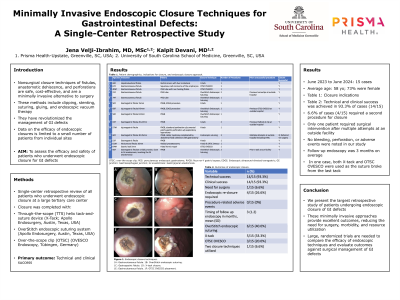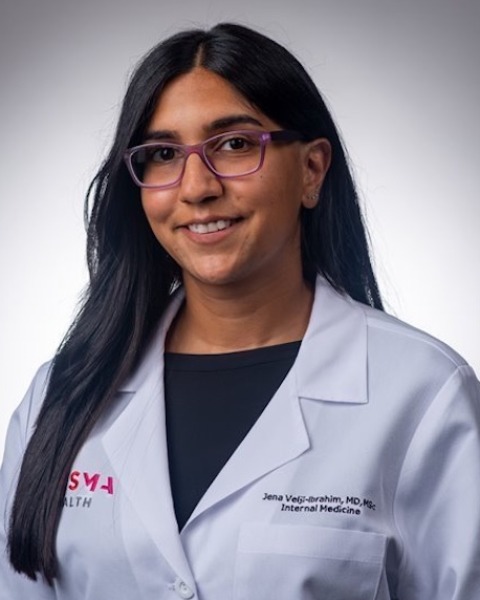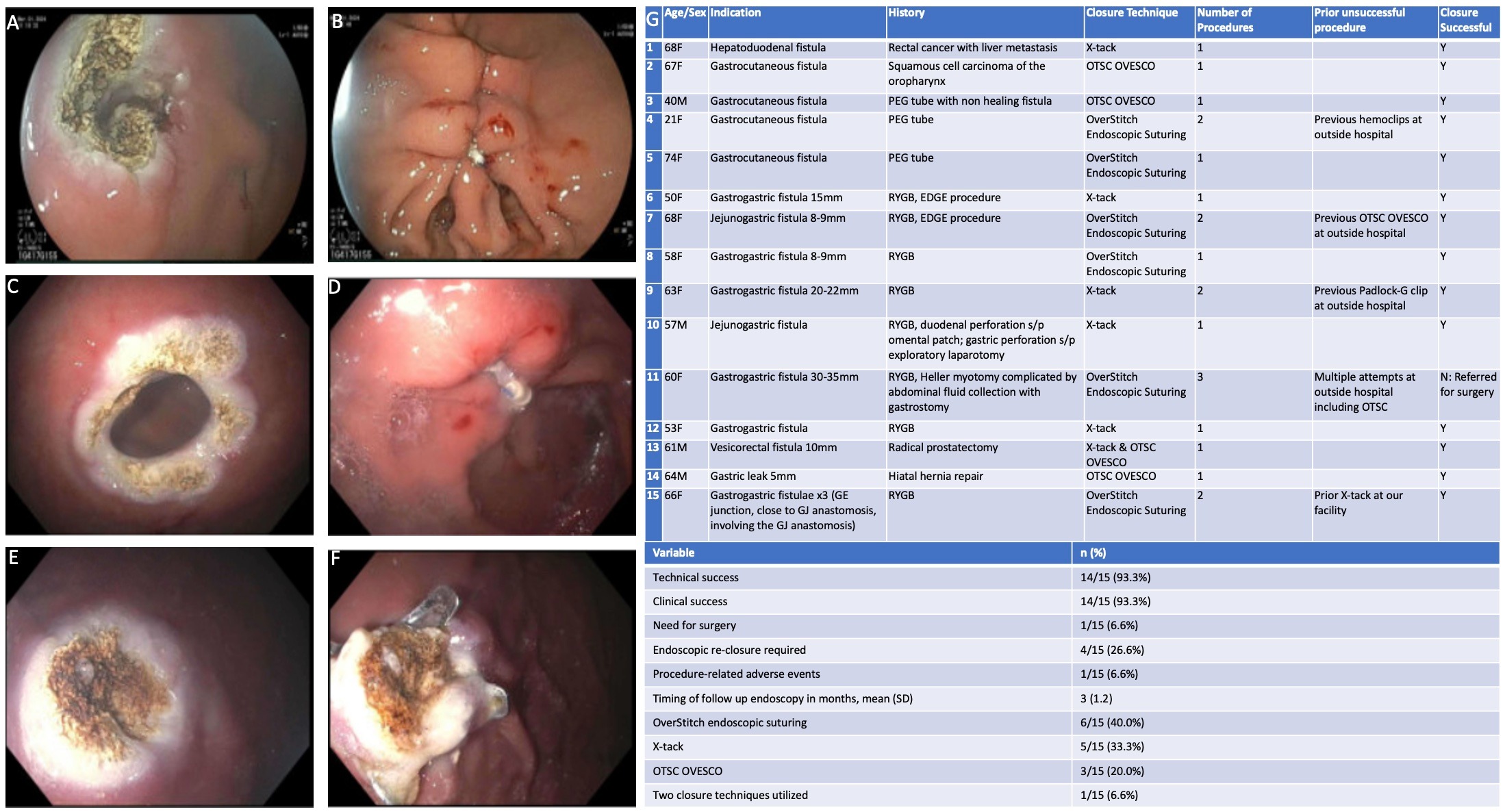Sunday Poster Session
Category: Interventional Endoscopy
P1061 - Minimally Invasive Endoscopic Closure Techniques for Gastrointestinal Defects: A Single-Center Retrospective Study
Sunday, October 27, 2024
3:30 PM - 7:00 PM ET
Location: Exhibit Hall E

Has Audio

Jena Velji-Ibrahim, MD, MSc
Prisma Health-Upstate/University of South Carolina School of Medicine
Greenville, SC
Presenting Author(s)
Jena Velji-Ibrahim, MD, MSc, Kalpit Devani, MD
Prisma Health-Upstate/University of South Carolina School of Medicine, Greenville, SC
Introduction: Nonsurgical closure techniques for gastrointestinal (GI) defects, including fistulas and perforations have emerged as a safe, cost-effective, and minimally invasive alternative to surgery. These methods, such as clipping, stenting, suturing, gluing, and endoscopic vacuum therapy, have revolutionized the management of GI defects. Data on the efficacy of endoscopic closures is limited to a small number of patients. We aimed to assess the efficacy and safety of patients who underwent endoscopic closure for GI defects.
Methods: We conducted a single-center retrospective study of all patients who underwent endoscopic closure at a large tertiary care center. Closure was completed with through-the-scope (TTS) helix tack-and-suture device (X-Tack; Apollo Endosurgery, Austin, Texas, USA), OverStitch endoscopic suturing system (Apollo Endosurgery, Austin, Texas, USA), or over-the-scope clip (OTSC) (OVESCO Endoscopy, Tübingen, Germany). The primary outcomes were technical and clinical success.
Results: From June 2023 to June 2024, 15 patients were identified. The average patient age was 58 years old and 73% were female. Procedure indications included hepatoduodenal fistula (n=1), gastrocutaneous fistulas (n=4), gastrogastric fistulas (n=6), gastrojejunal fistulas (n=2), gastric leak (n=1), and vesicorectal fistula (n=1). 10 patients had no prior attempts at closure and 5 patients had prior attempts at our hospital or an outside hospital. Technical and clinical success was achieved in 93.3% of cases (14/15). 26.6% (4/15) required a second procedure for closure. Only one patient required surgical intervention after multiple attempts at endoscopic closure at an outside hospital. 1 patient had post-procedure bleeding after X-tack placement which was controlled endoscopically. No other procedure-related adverse events occurred. Follow-up endoscopy was 3 months on average. In one case, X-tack and OTSC OVESCO were used as the suture broke from the last tack. See Figure 1 for closure illustration and outcomes.
Discussion: We present the largest retrospective analysis of patients undergoing endoscopic closure of GI defects. We highlight the utility of various closure procedures, advocating for a multidisciplinary approach to managing fistulas and leaks. These minimally invasive approaches provide excellent outcomes, reducing the need for surgery, morbidity, and resource utilization. Large, randomized trials are needed to compare the efficacy of endoscopic techniques to surgical management of GI wall defects.

Note: The table for this abstract can be viewed in the ePoster Gallery section of the ACG 2024 ePoster Site or in The American Journal of Gastroenterology's abstract supplement issue, both of which will be available starting October 27, 2024.
Disclosures:
Jena Velji-Ibrahim, MD, MSc, Kalpit Devani, MD. P1061 - Minimally Invasive Endoscopic Closure Techniques for Gastrointestinal Defects: A Single-Center Retrospective Study, ACG 2024 Annual Scientific Meeting Abstracts. Philadelphia, PA: American College of Gastroenterology.
Prisma Health-Upstate/University of South Carolina School of Medicine, Greenville, SC
Introduction: Nonsurgical closure techniques for gastrointestinal (GI) defects, including fistulas and perforations have emerged as a safe, cost-effective, and minimally invasive alternative to surgery. These methods, such as clipping, stenting, suturing, gluing, and endoscopic vacuum therapy, have revolutionized the management of GI defects. Data on the efficacy of endoscopic closures is limited to a small number of patients. We aimed to assess the efficacy and safety of patients who underwent endoscopic closure for GI defects.
Methods: We conducted a single-center retrospective study of all patients who underwent endoscopic closure at a large tertiary care center. Closure was completed with through-the-scope (TTS) helix tack-and-suture device (X-Tack; Apollo Endosurgery, Austin, Texas, USA), OverStitch endoscopic suturing system (Apollo Endosurgery, Austin, Texas, USA), or over-the-scope clip (OTSC) (OVESCO Endoscopy, Tübingen, Germany). The primary outcomes were technical and clinical success.
Results: From June 2023 to June 2024, 15 patients were identified. The average patient age was 58 years old and 73% were female. Procedure indications included hepatoduodenal fistula (n=1), gastrocutaneous fistulas (n=4), gastrogastric fistulas (n=6), gastrojejunal fistulas (n=2), gastric leak (n=1), and vesicorectal fistula (n=1). 10 patients had no prior attempts at closure and 5 patients had prior attempts at our hospital or an outside hospital. Technical and clinical success was achieved in 93.3% of cases (14/15). 26.6% (4/15) required a second procedure for closure. Only one patient required surgical intervention after multiple attempts at endoscopic closure at an outside hospital. 1 patient had post-procedure bleeding after X-tack placement which was controlled endoscopically. No other procedure-related adverse events occurred. Follow-up endoscopy was 3 months on average. In one case, X-tack and OTSC OVESCO were used as the suture broke from the last tack. See Figure 1 for closure illustration and outcomes.
Discussion: We present the largest retrospective analysis of patients undergoing endoscopic closure of GI defects. We highlight the utility of various closure procedures, advocating for a multidisciplinary approach to managing fistulas and leaks. These minimally invasive approaches provide excellent outcomes, reducing the need for surgery, morbidity, and resource utilization. Large, randomized trials are needed to compare the efficacy of endoscopic techniques to surgical management of GI wall defects.

Figure: Figure 1. Endoscopic closure techniques and outcomes. 1A exhibits a gastrocutaneous fistula and 1B illustrates closure with OverStitch endoscopic suturing. 1C illustrates a gastrogastric fistula and 1D demonstrates X-tack closure. 1E highlights a gastrocutaneous fistula and 1F exhibits OTSC OVESCO placement. 1G illustrates all patient demographics, indications for closure, and endoscopic closure approach. Outcomes of endoscopic closure are also detailed. OTSC: over-the-scope clip; PEG: percutaneous endoscopic gastrostomy; RYGB: Roux-en-Y gastric bypass; EDGE: Endoscopic ultrasound-directed transgastric ERCP; GE junction: Gastroesophageal junction; GJ anastomosis: Gastrojejunal anastomosis.
Note: The table for this abstract can be viewed in the ePoster Gallery section of the ACG 2024 ePoster Site or in The American Journal of Gastroenterology's abstract supplement issue, both of which will be available starting October 27, 2024.
Disclosures:
Jena Velji-Ibrahim indicated no relevant financial relationships.
Kalpit Devani indicated no relevant financial relationships.
Jena Velji-Ibrahim, MD, MSc, Kalpit Devani, MD. P1061 - Minimally Invasive Endoscopic Closure Techniques for Gastrointestinal Defects: A Single-Center Retrospective Study, ACG 2024 Annual Scientific Meeting Abstracts. Philadelphia, PA: American College of Gastroenterology.
